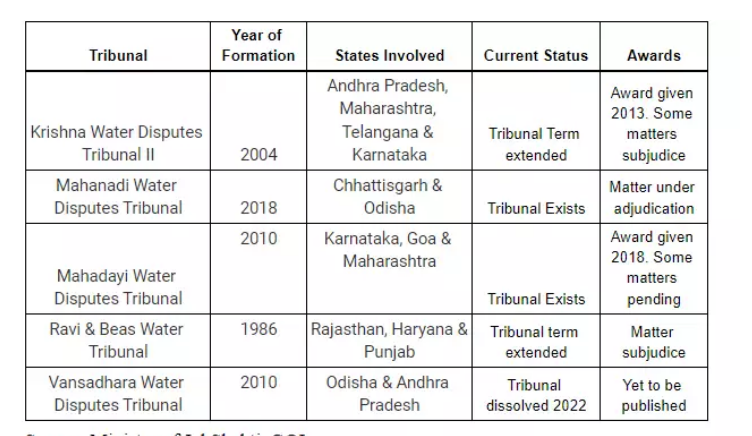Inter-State Water Dispute | 27 Apr 2023
For Prelims: Inter-State Water Dispute, Inter-State River Water Disputes (ISRWD) Act 1956, Mahanadi Water Disputes Tribunal, Mahanadi River.
For Mains: Inter-State Water Dispute and Resolution.
Why in News?
Odisha has complained to the Ministry of Jal Shakti under the Inter-State River Water Disputes (ISRWD) Act 1956 accusing Chhattisgarh of misleading the Mahanadi Water Disputes Tribunal (MWDT) by releasing water in Mahanadi river in the Non-Monsoon Season.
- The MWDT was formed in March 2018. The tribunal has been asked to submit its report by December 2025 by the Ministry of Jal Shakti.
- There is no inter-state agreement between Odisha and Chhattisgarh regarding Mahanadi basin water allocation.
What is the Concern of Odisha?
- Chhattisgarh has opened 20 gates at Kalma Barrage through which 1,000-1,500 cusecs of water is flowing into Mahanadi’s low catchment area during the non-monsoon season.
- Chhattisgarh’s reluctance to release water during non-monsoon seasons has often resulted in the non-availability of water in the lower catchment of Mahanadi.
- This also affects the Rabi crops and aggravates the drinking problem in Odisha.
- However, this time Chhattisgarh has released water without any intimation, which raised concerns over its management of Mahanadi River water.
- The state faced flood in upper catchment during monsoon and thus, opened gates without any intimation to Odisha.
What are the Inter-State River Disputes in India?
- About:
- The Inter-State River Water Disputes are one of the most contentious issues in Indian federalism today.
- The recent cases of the Krishna Water Dispute, Cauvery Water Dispute and the Satluj Yamuna Link Canal are some examples.
- Various Inter-State Water Disputes Tribunals have been constituted so far, but they had their own problems.
- The Inter-State River Water Disputes are one of the most contentious issues in Indian federalism today.
- Constitutional Provisions:
- Entry 17 of the State List deals with water i.e., water supply, irrigation, canal, drainage, embankments, water storage and hydro power.
- Entry 56 of the Union List empowers the Union Government for the regulation and development of inter-state rivers and river valleys to the extent declared by Parliament to be expedient in the public interest.
- According to Article 262, in case of disputes relating to waters:
- Parliament may by law provide for the adjudication of any dispute or complaint with respect to the use, distribution or control of the waters of, or in, any inter-State River or river valley.
- Parliament may, by law, provide that neither the Supreme Court nor any other court shall exercise jurisdiction in respect of any such dispute or complaint as mentioned above.
What is the Mechanism for Inter-State River Water Disputes Resolution?
- As per Article 262, the Parliament has enacted the following:
- River Board Act, 1956: This empowered the GoI to establish Boards for Interstate Rivers and river valleys in consultation with State Governments. To date, no river board has been created.
- Inter-State Water Dispute Act, 1956: In case, if a particular state or states approach the Centre for the constitution of the tribunal, the Central Government should try to resolve the matter by consultation among the aggrieved states. In case, if it does not work, then it may constitute the tribunal.
- Note: Supreme Court shall not question the Award or formula given by tribunal, but it can question the working of the tribunal.
- The Inter-State Water Dispute Act, 1956 was amended in 2002, to include the major recommendations of the Sarkaria Commission.
- The amendments mandated a one-year time frame to set up the water disputes tribunal and also a 3-year time frame to give a decision.
What are the Issues with Interstate Water Dispute Tribunals?
- Protracted proceedings and extreme delays in dispute resolution. Water disputes such as the Godavari and Cauvery disputes in India have faced long delays in resolution.
- Opacity in the institutional framework and guidelines that define these proceedings; and ensuring compliance.
- The composition of the tribunal is not multidisciplinary, and it consists of persons only from the judiciary.
- The absence of water data that is acceptable to all parties currently makes it difficult to even set up a baseline for adjudication.
- The growing nexus between water and politics has transformed the disputes into turfs of vote bank politics.
- This politicisation has led to increasing defiance by states, extended litigations and subversion of resolution mechanisms.
What Measures can be taken to Resolve Water Disputes?
- Bring Inter-state water disputes under interstate council constructed by the president under article 263 and need for consensus-based decision making.
- States must be motivated for water use efficiency in every domain and water harvesting and water recharging to reduce the demand on river water and in situ water source.
- Need of a single water management agency for both ground and surface water on scientific basis and also for technical advice on union, river basin, state and district level for water conservation and water management.
- Tribunals must be fast track, technical and also have a verdict enforceable mechanism in a time bound manner.
- A central repository of water data is necessary for informed decision making. It is important for the central government to take a more active role in resolving inter-state water disputes.
UPSC Civil Services Examination, Previous Year Question (PYQ)
Mains
Q. Constitutional mechanisms to resolve the inter-state water disputes have failed to address and solve the problems. Is the failure due to structural or process inadequacy or both? Discuss. (2013)

